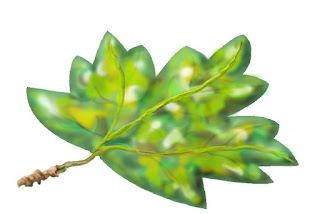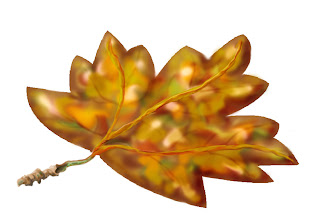Autumn + nature blog = a requirement to write about autumn leaves. So here we go. 'Why Leaves Turn Red’ in 50 seconds (or more) ...
When deciduous trees sense night is longer than it used to be they make preparations to shut down for the winter. A corky layer of cells, called the
abscission layer, develops between the twig and leaf stalk which blocks nutrients from the tree reaching the leaf. The leaf gradually becomes isolated and whatever further chemical reactions take place is done within the confines of that single leaf.
 |
| Abscission Layer Grows to Cut Off Nutrients |
Now, we all know the green colour of leaves comes from
chlorophyll, the pigments of photosynthesis. Another pigment, yellow, also exists within the leaf, but is masked by the green chlorophyll. The yellow comes from
carotene (yes, the one you take in your multivitamin pills). This absorbs light energy and facilitates chlorophyll in making carbohydrates for the tree to use.
 |
| Chlorophyll and Carotenoids Exist At Same Time |
Chlorophyll is a not a stable compound. Sunlight quickly decomposes it. This is not a problem during the summer as the leaf is open to nutrients from the rest of the tree, and the compound is continuously replaced. But in autumn, when that connection is slowly reduced chlorophyll within the leaf gradually dies away. Yellow carotene, which is not as sensitive, survives longer, and turns the leaf into the archetypal golden colours we admire.
 |
| Chlorophyll Decays To Reveal Carotenoids |
Chlorophyll doesn’t disappear completely. Some still survives and continues to do its job to produce carbohydrate. But with the route back into the tree greatly reduced the level of carbohydrate increases within the leaf. These sugars and starches promote the creation of a new pigment, red, from a group of chemicals called
anthocyanins. (We’ve met these before in
purple beans.) Anthocyanins are anti-oxidants - which is why we are encouraged to eat colourful fruit and veg., but even in this case of the decaying leaf they are useful. The chlorophyll molecule has a valuable amount of nitrogen in it that the tree doesn’t want to lose, so over the course of autumn chlorophyll is allowed to decompose to make nitrogen available for reabsorbtion. Scientists think the anthocyanins act as protective agents that keep things healthy enough to allow these last processes to complete.
 |
| Anthocyanins Begin To Accumulate |
 |
| Red And Purple Anthocyanins |
There is also another less attractive pigment in the leaf – brown
tannin. As with anthocyanins they are a group of chemicals that have protective qualities. Like the captain of a ship they are the last pigments to survive the death of the leaf and they stoically accompany it to the ground when all is finished.
 |
| Brown Tannins Accumulate |
 |
| The End |
Then cold quiet winter stalks the land.






